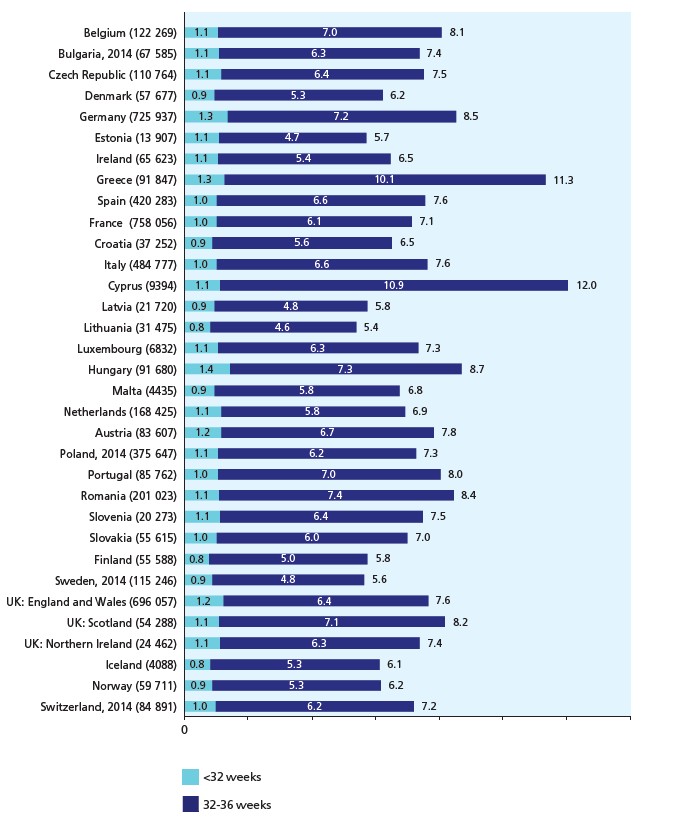Questions and Answers
According to the World Health Organization, “preterm” refers to a baby born before 37 weeks of pregnancy have been completed. Normally, a pregnancy lasts about 40 weeks.
There are sub-categories of birth, based on gestational age:
- Extremely preterm (<28 weeks)
- very preterm (28 to <32 weeks)
- moderate to late preterm (32 to <37 weeks)
“Very low birth weight” refers to babies who are born weighing less than 1,500 grams (3 pounds, 4 ounces). Only a few babies, 1.5 percent, are born this small. Often, babies with (very) low birth weight are also born preterm.
How many babies are born preterm every year and what is the situation in Europe?
Preterm birth can happen to anyone. It occurs in high, low, and middle-income countries. About 15 million babies are born preterm each year; that is more than 1 in 10 babies worldwide.
In Europe[1], preterm birth is one of the leading causes for neonatal mortality and accounts for more than half of all infant deaths. Prevalence rates of preterm birth range from 5.2 to 10.4 % – an average of 7.2% of all live births .
Percentage of live births with a gestational age<32 weeks and between 32-36 weeks in 2015

(1) Althabe F, Howson CP, Kinney M, Lawn J, World Health Organization. Born too soon: the global action report on preterm birth. 2012. Available from: www.who.int/pmnch/media/news/2012/201204_borntoosoon-report.pdf
(2) Zeitlin J, Delnord M, Mohangoo AD. EURO-PERISTAT Project with SCPE and EUROCAT. European Perinatal Health Report. The health and care of pregnant women and babies in Europe in 2010. 2013. Available from: www.europeristat.com (Date of visit: 25.08.2016)
The survival rate for babies born too soon is continuously improving thanks to advances made in science and care. However, associations and organizations of parents and healthcare specialists no longer focus their attention on methods designed to ensure the survival of preterm babies, but also examine the options open to give these babies the very best possible start in life.
In about half of all cases of preterm birth, the exact cause of the early delivery still remains unknown.
Nonetheless, a number of risk factors have been identified as likely to increase the risk of preterm labor. These risk factors include lifestyle factors, medical conditions and demographic factors. A few examples of associated risks include: multiple pregnancy (twins, triplets or more), preterm birth experienced in a previous pregnancy, uterine or cervical abnormalities, infections, and maternal age. In industrialized countries, such as those in Europe, the proportion of women giving birth after the age of 35 years has risen considerably, increasing preterm delivery risk. Also, studies show the connection between pregnancy complications and an increased risk for preterm birth, including lower birth weight and psychological factors like anxiety and depression. In addition, preterm birth is also more frequent among socially disadvantaged women who have less access to health care and more difficult life circumstances.
Source: EFCNI White Paper “Caring for Tomorrow”: http://www.efcni.org/index.php?id=2143
Preterm babies are not fully prepared to live outside their mother’s womb. The earlier in pregnancy babies are born, the less developed their organs will be. Many health conditions can result from the immaturity of important organs and systems including lung, heart, digestive tract, brain, immune system, and eyes.
Medical support aims at helping a baby born preterm to achieve similar growth and development as in the womb at the same age. The medical team needs to recognize and monitor the special needs of a preterm baby to provide appropriate care and support until the baby reaches maturity of most important body functions.
Extensive information about prevention during pregnancy, treatment and care in the neonatal intensive care unit and other topics around preterm birth can be found on the website of the European Foundation for the Care of Newborn Infants (EFCNI). EFCNI is the first pan-European organization to represent the voice of preterm infants and their families and is representing the parental voice in the RECAP preterm project.
On the website of the European Foundation for the Care of Newborn Infants (EFCNI) you can find the links to parent or patient organizations who are active in your country. Contact EFCNI and/ or the national organization to find support in the country where you are located.
There are cohort studies of VP/VLBW in various countries. However, most of these are too small to do complex analysis such as determining the outcomes after neonatal treatment and in particular finding out what helps VPT/VLBW to beat the odds. By combining data from various cohorts, power for statistical analysis is increased and universal factors that can help VPT/VLBW across various countries can be identified.
Furthermore, building an interactive database will not only provide researchers around the world an easier access to valuable information, but it will also lay the foundation for future studies to be set up in Europe.
Learning what treatments neonatally or during the development of VPT/VLBW children (e.g. parenting, schooling) are related to positive outcomes will inform the development of personalized interventions to benefit VPT/VLBW and their families and help reduce suffering and reduce cost for society.
Are patient or parent organizations involved in the project and what is their role?
Parent organizations bundle the knowledge and experience of families who experienced a preterm birth. From their own experiences and the experiences of the families they work with, they have acquired a wealth of knowledge about life in the hospital and after discharge. These experiences are of great importance and add to the expertise of the different health professions.
EFCNI as European umbrella organization is representing the families of preterm and ill-born children. Together with the project partners, EFCNI tries to extend the network to all relevant stakeholders in the different European countries and foster the implementation of effective prevention, treatment and care and follow-up for preterm and low birth weight babies.
What do you want to know about the RECAP preterm Project? Send us your questions!
